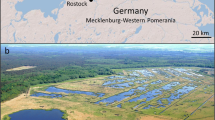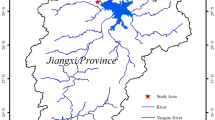Abstract
This study was undertaken at Horqin Sand Land, Inner Mongolia, Northern China. Field samples of biological soil crusts (BSCs) and underlying topsoil (0–5 cm under BSC) were taken in areas of different dune stabilization stages, and their physicochemical properties were analyzed, including particle size distribution, bulk density, organic matter, nitrogen, phosphorus, electrical conductivity (EC), pH, and CaCO3 content. The results revealed that semi-mobile dunes, semi-fixed dunes and fixed dunes had developed a physical crust, algae crust and moss crust, respectively. The thickness, hardness, water content, fine fraction and nutrient contents of BSCs were gradually increasing along the dune stabilization gradient. Meanwhile, BSC establishment and development enhanced the bulk density, silt and clay content, and nutrients of the topsoil under it, in an increasing tend from semi-mobile dune to fixed dune. Organic matter concentrations and other nutrients in the 0–5 cm topsoil layer under BSCs were significantly higher compared to unconsolidated soil (control). Moreover, there were strong significant positive correlations between topsoil and BSCs’ organic matter, total nitrogen, available nitrogen, available phosphorus, CaCO3, and <0.05 mm particle content, suggesting that BSCs have an influence on some of the properties of the underlying topsoil.



Similar content being viewed by others
References
Belnap J (2002) Nitrogen fixation in biological soil crusts from southeast Utah, USA. Biol Fertil Soils 35:128
Belnap J, Gillette DA (1997) Disturbance of biological soil crust: impacts on potential wind erodibility of sandy desert soils in southeastern Utah. Land Degeneration Dev 8: 355–362
Bowker MA (2007) Biological soil crust rehabilitation in theory and practice: an underexploited opportunity. Restor Ecol 15(1):13–23
Brostoff WN (2002) Cryptobiotic crusts of a seasonally inundated Dune-Pan system at Edwards Air Force Base, Western Mojave desert, California. J Arid Environ 51:339–361
Duan ZH, Wang G, Xiao HL, Dong ZB (2003) Abiotic soil crust formation on dunes in an extremely arid environment: a 43-year sequential study. Arid Land Res Manage 17:43–54
Eldridge DJ (1993) Cryptogams, vascular plants, and soil hydrological relations: some preliminary results from the semiarid wood lands of eastern Australia. Great Basin Nat 53:48–58
Eldridge DJ, Greene RS (1994) Microbiotic soil crusts: a view of their roles in soil and ecological processes in the rangelands of Australia. Aust J Soil Res 32:389
Eldridge DJ, Zaady E, Shachak M (2000) Infiltration through three contrasting biological soil crusts in patterned landscapes in the Negev, Israel. Catena 40:323–336
Evans RD, Ehleringer JR (1993) A break in the nitrogen cycle of aridlands? Evidence from δ15 N of soils. Oecologia 94:314–317
Fang HY, Cai QG, Chen H, Li QY (2007) Mechanism of formation of physical soil crust in desert soils treated with straw checkerboards. Soil Tillage Res 93:222–230
Fang W, Peng S (1997) Development of species diversity in the restoration process of establishing a tropical man-made forest ecosystem in China. For Ecol Manage 99:185–196
Hawkes CV (2004) Effects of biological soil crusts on seed germination of four endangered herbs in a xeric Florida shrubland during drought. Plant Ecol 170:121–134
Issa OM, Bissonnais YL, Defarge C, Trichet J (2001) Role of a cyanobacterial cover on structural stability of sandy soils in the Sahelian part of western Niger. Geoderma 101:15–30
ISSCAS (1978) Institute of Soil Sciences, Chinese Academy of Sciences. Physical and chemical analysis methods of soils. Shanghai Science Technology Press, Shanghai, pp 7–59
Jonathan HT, Robert SN, Stanley DS (2002) Soil resource heterogeneity in the Mojave Desert. J Arid Environ 52:269–292
Kidron GJ, Barzilay E, Sachs E (2000) Microclimate control upon sand microbiotic crusts, western Negev desert, Israel. Geomorphology 36:1–18
Lange OL, Meyer A, Zellner H, Hever U (1994) Photosynthesis and water relationships of lichen soil crusts: field measurements in the coastal fog zone of the Namib desert. Funct Ecol 8:253–264
Langston G, Neuman CM (2005) An experimental study on the susceptibility of crusted surfaces to wind erosion: a comparison of the strength properties of biotic and salt crusts. Geomorphology 72:40–53
Leys JF, Eldridge DJ (1998) Influence of microbiotic crust disturbance to wind erosion on sand and loam rangeland soils. Earth Surf Process Landforms 23:963–974
Li XR, Wang XP, Li T (2002) Microbiotic soil crust and its effect on vegetation and habitat on artificially stabilized desert dunes in Tengger Desert, Northern China. Biol Fertil Soils 35:147–154
Li XR, Zhang JG, Wang XP, Liu LC, Xiao HL (2000) Study on soil microbiotic crust and its influences on sand-fixing vegetation in arid desert region. Acta Bot Sin 42(9):965–970
Ling YQ, QuJJ, Hu M (1993) Formation of sand surface crust and microenvironmental changes. Chin J Appl Ecol 4:393–398 (in Chinese with English abstract)
Liu SR, Li XM, Niu LM (1998) The degradation of soil fertility in pure larch plantations in the northeastern part of China. Ecol Eng 10:75–86
Nelson D, Sommers L (1982) Total carbon, organic carbon and organic matter. In: Page AL et al (eds) Methods of soil analysis, part 2, 2nd edn. ASA Publication No. 9, Madison, pp 539–577
Schlesinger WH, Raikes JA, Hartley AE, Cross AF (1996) On the spatial pattern of soil nutrients in desert ecosystems. Ecology 77:364–374
Schulten JA (1985) Soil aggregation by cryptogams of a sand prairie. Am J Bot 72:1657–1661
Stradling DA, Thygerson T, Walker JA, Smith BN, Hansen LD, Criddle RS, Pendleton RL (2002) Cryptogamic crust metabolism in response to temperature, water vapor, and liquid water. Thermochim Acta 394:219–225
Su YZ, Zhao HL (2003) Soil properties and plant species in an age sequence of Caragana microphylla plantations in the Horqin Sandy Land, north China. Ecol Eng 20:223–235
Su YZ, Zhao HL, Zhang TH, Zhao XY (2004) Soil properties following cultivation and non-grazing of a semi-arid sandy grassland in northern China. Soil Tillage Res 75:27–36
Thomas AD, Dougill AJ (2006) Distribution and characteristics of cyanobacterial soil crusts in the Molopo Basin, South Africa. J Arid Environ 64:270–283
Verrecchia E, Yair A, Kidron GJ, Verrecchia K (1995) Physical properties of the psammophile microbiotic crust and their consequences to the water regime of sandy soils, northwestern Negev Desert, Israel. J Arid Environ 29:427–437
Wang T (2000) Land use and sandy desertification in the north China. China J Desert Res 20(2):103–113 (in Chinese with English abstract)
Xiao HL Zhang JX, Li JG (1996) Study on nutrient element cycle in artificial vegetation district of Shapotou. J Desert Res 16(Suppl 1):76–79 (in Chinese with English abstract)
Zhang JY, Zhao HL, Zhang TH, Zhao XY, Drake S (2005) Community succession along a chronosequence of vegetation restoration on sand dunes in Horqin Sandy Land. J Arid Environ 62:555–566
Zhang YM, Wang HL, Wang XQ, Yang WK, Zhang DY (2006) The microstructure of microbiotic crust and its influence on wind erosion for a sandy soil surface in the Gurbantunggut Desert of Northwestern China. Geoderma 132:441–449
Zhu Z, Chen G (1994) The sandy desertification in China, vol 7. Science Press, Beijing, p 268 (in Chinese)
Acknowledgments
We thank Yulin Li, Yuqiang Li, Shaokun Wang, Yayong Luo for assistance in the field and lab. We also thank two anonymous reviewers whose comments greatly improved the manuscript. Funding was provided by projects of National Natural Science Foundation (40601008) of China, and the Field Station Foundation (No. 1731690200015) of Chinese Academy of Sciences.
Author information
Authors and Affiliations
Corresponding author
Rights and permissions
About this article
Cite this article
Guo, Y., Zhao, H., Zuo, X. et al. Biological soil crust development and its topsoil properties in the process of dune stabilization, Inner Mongolia, China. Environ Geol 54, 653–662 (2008). https://doi.org/10.1007/s00254-007-1130-y
Received:
Accepted:
Published:
Issue Date:
DOI: https://doi.org/10.1007/s00254-007-1130-y




